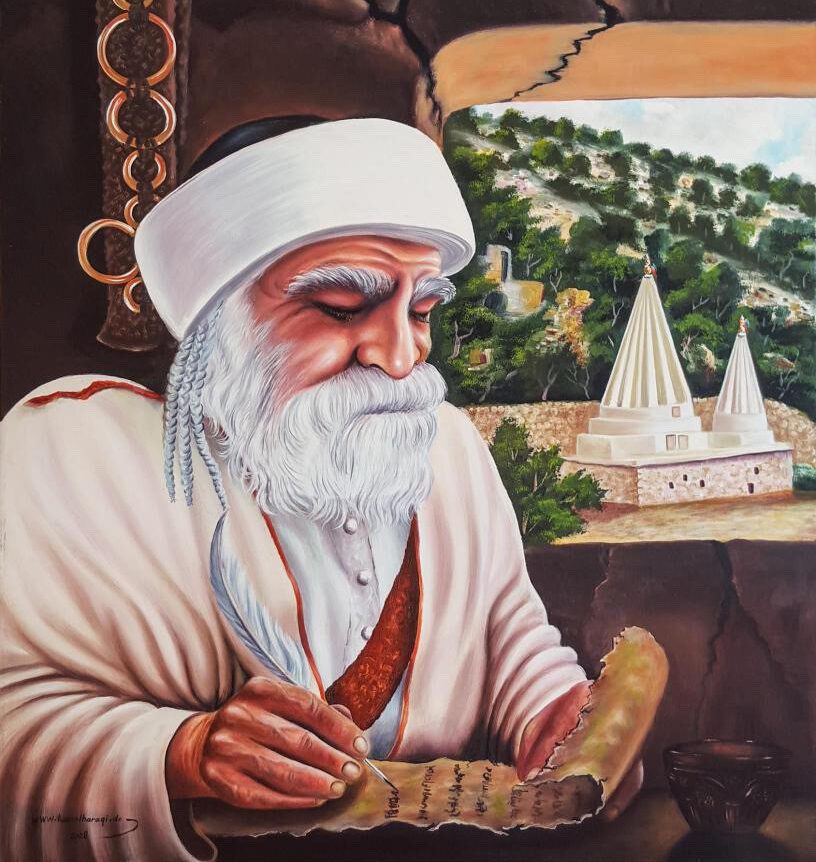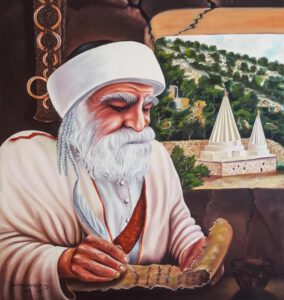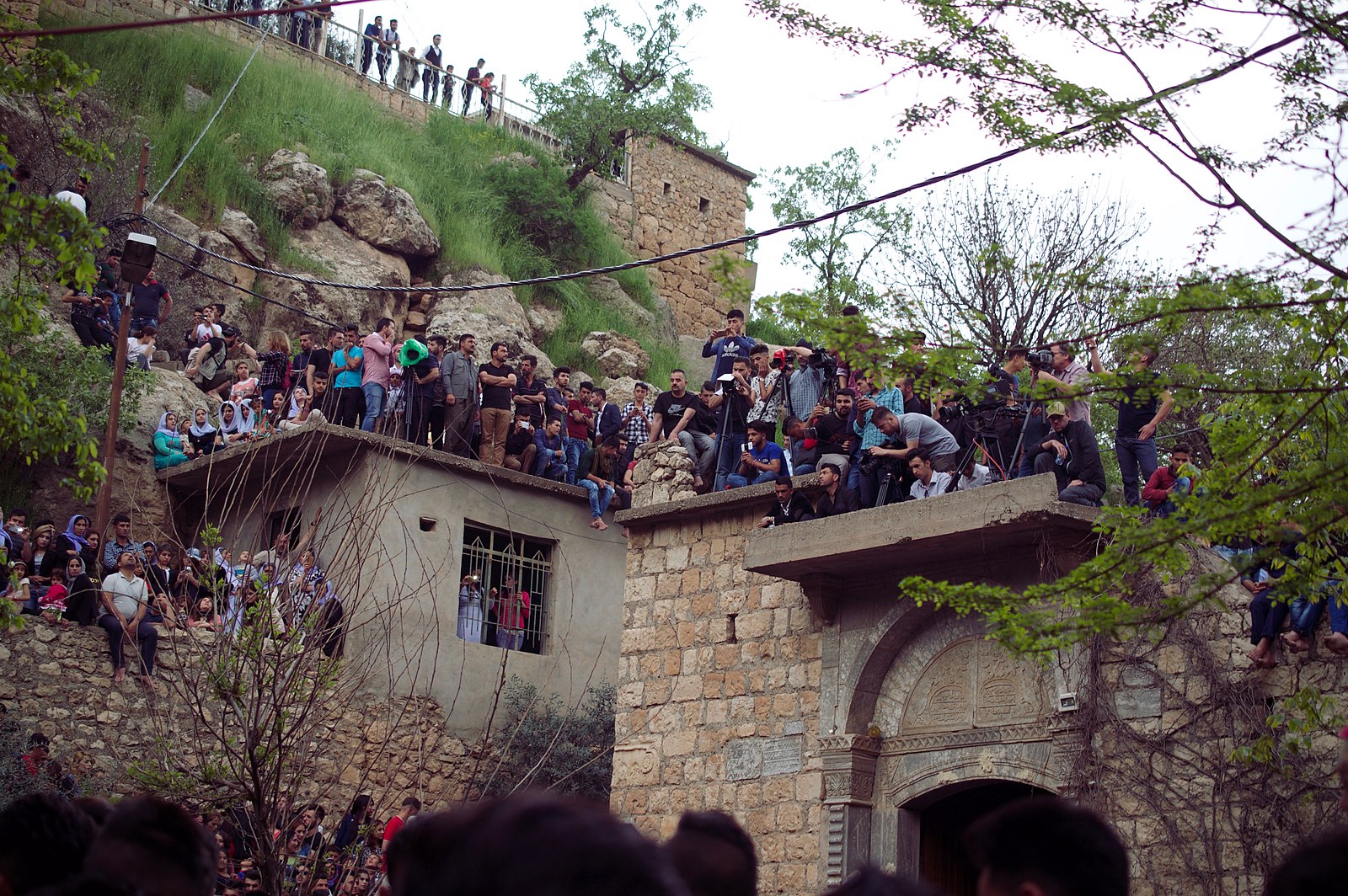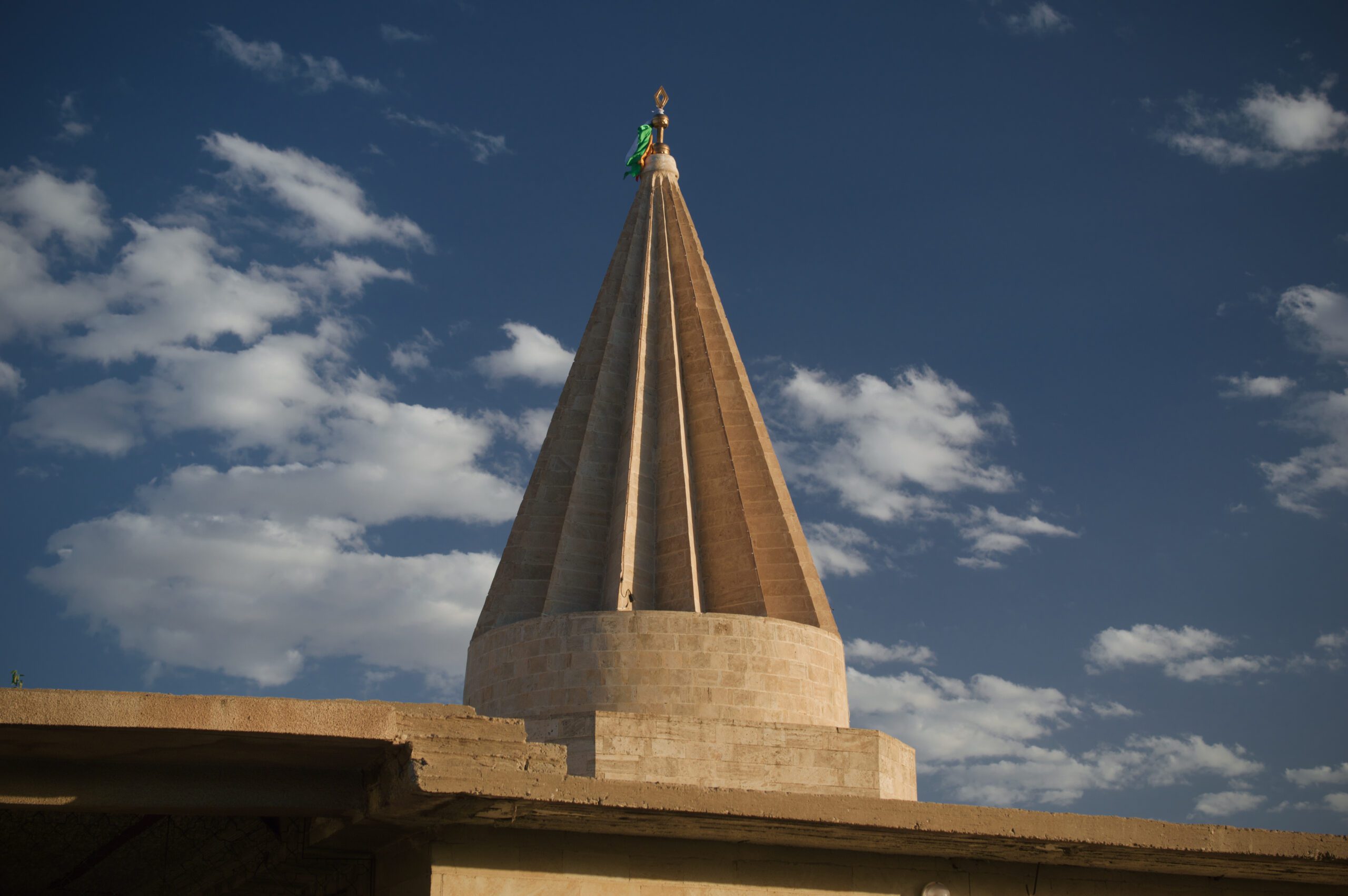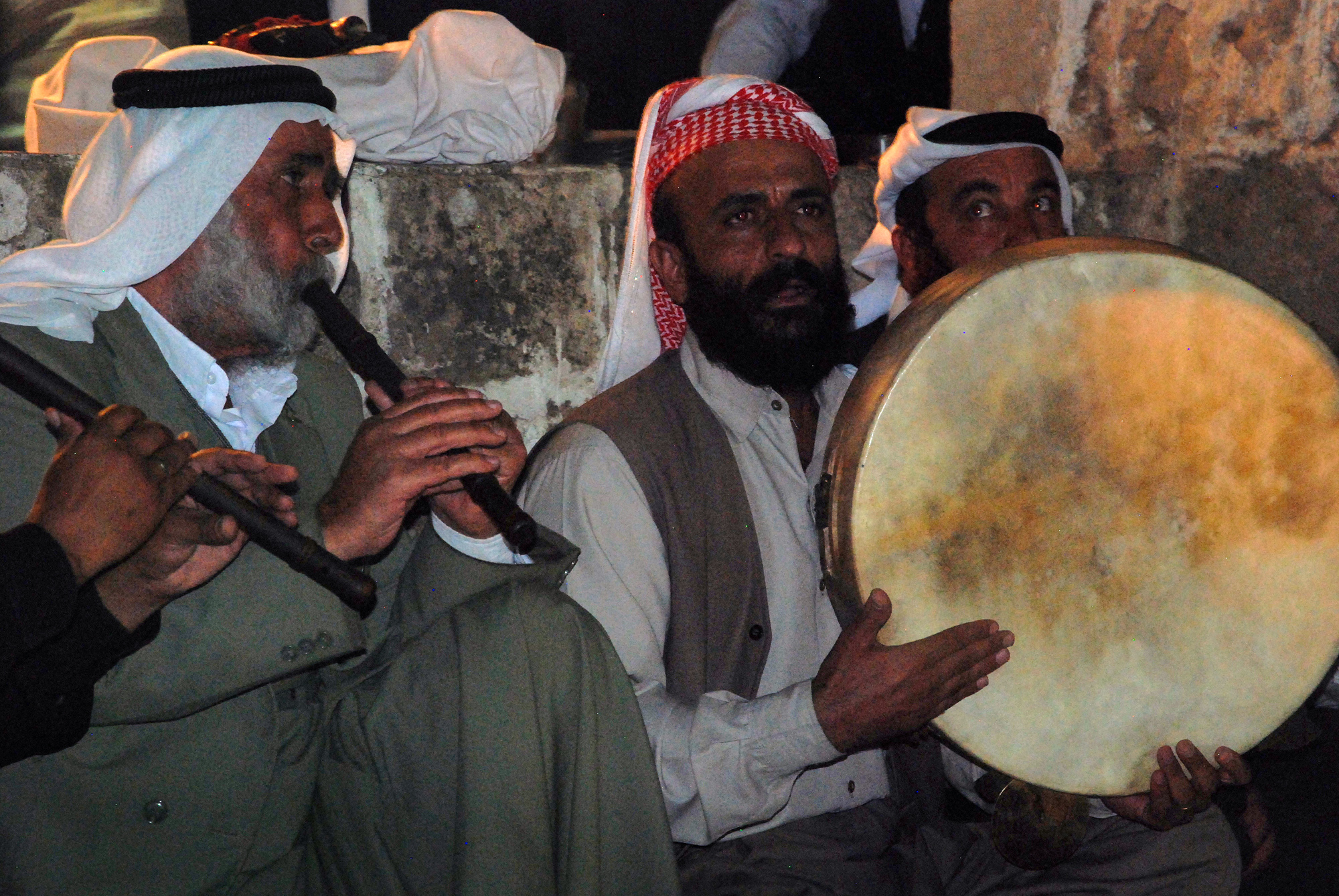Qewlê Şêxê Hesenî Siltan e
Qewlê Şêxê Hesenî Siltan e (Hymn of Şêx Hesen is the Sultan), is a ‘Berane’ Qewl believed to have been composed by Melek Fexredîn. The Qewl tells about grief and fate, and about the power of Şêx Hesen (Melik Şêxsin), an Ezidi holy figure. Among the Ezidis of Iraqi Kurdistan, this Qewl is performed mainly during Sema’ sessions. It is often accompanied by the recitation of Qewlê Kofa. It is also one of the Qewls performed at a grave (‘ser mezela’) upon the request of the deceased’s family, however, it is not recited for all of the deceased, namely not for children, young people and women. During the funerals among the Ezidis of the Transcaucasus countries, it is performed in a solemn manner together by two or three people, who are often from the priestly castes of Sheikhs and Pirs. The Qewl is also called Qewlê Borê-Borê because of a repeated refrain in the Qewl: ‘Laliş ya bor, dîwan ya bor, Merge ya bor, ya bor, ya bor.’ [1]de la Bretèque, Estelle Amy; Omarkhali, Khanna (26 September 2022). “The Yezidi Religious Music“[2]Omarkhali, Khanna. (2017). “The Yezidi Religious Textual Tradition: From Oral to Written Categories, Transmission, Scripturalisation and Canonisation of the Yezidi Oral Religious Texts.” … Continue reading The phrase “ya bor” can be translated to “Oh steed” and is sometimes used as an admonition to an egoistic soul (‘nefs’), which must obey a higher soul just as a steed obeys its rider.
Version 1
The following version, which consists of 13 stanzas, was transcribed by the Ezidi scholar Bedelê Feqîr Hecî from a cassette and published in the Dengê Êzidiyan magazine in 2001. Later he also published it in his book “Bawerî û Mîtologiya Êzidîyan: Çendeha Têkist û Vekolîn“. The name of the reciter is not provided. This version was translated into English by the present author of this article.
Stanza 1:
1. Şêxê Hesenî Siltan e,
Şêx Hesen is the Sultan,
2. Hey ezîzê mala bavê mino,
O dear one of my father’s home,
3. Babê qelpê rehman e,
A father whose heart is merciful,
4. Mîrê qelendera(n), hey li min hayê,
The Prince of the qelenders (“wandering dervishes”), hey li min hayê,[3]As explained by the researchers Khanna Omarkhali and Estelle Amy de la Bretèque, the syllables/words such as “yay, oy, ayê, yê, way, ey li min ê or ay li min ê” have no clear … Continue reading
5. Laliş ye bor, dîwan ye bor, yabor ye bor.
Stanza 2:
1. Şêxê Hesenî Feqîr e,
Şêx Hesen is the Feqîr,
2. Hey ezîzê mala babê mino qelpê mîr e,
Oh dear one of the home of my father, whose heart [belongs] to the Mîr,
3. Mîrê qelendera(n) hey li min hayê,
The Prince of the qelenders, hey li min hayê,
4. Laliş ye bor, dîwan ye bor, Mergeh ye bor, yabor ye bor,
5. Ya birîndarê mêrano, ew Siltan Şîx Adî ye li hemû derdan yi xebîr e.
O wounded one among men, it is Sultan Sheikh Adi who knows [how to heal] all pains.
Stanza 3:
1. Şêxê Hesenî Seyîd e,
Şêx Hesen is the Master,
2. Hey ezîzê mala bavê mino qelpê mirîd e,
O dear one of the home of my father, whose heart [belongs] to the Mirîds,
3. Mîrê qelendera(n) hey li min hayi yê,
The Prince of the qelenders, hey li min hayê,
4. Laliş ye bor, dîwan ye bor, Mergeh ye bor, yabor ye bor,
5. Ya birîndarê mêrano, deriyê mirazan heyî Siltan Êzîd e.
O wounded one among men, the Gate of Wishes belongs to Siltan Êzîd.
Stanza 4:
1. Şêxê Hesenî mezin e,
Şêx Hesen is great,
2. Hey ezîzê mala babê mino babê qelpê momin e,
O dear one of the home of my father, whose heart [belongs] to the believers,
3. Mîrê qelendera(n) hey li min heyê,
The Prince of the qelenders, hey li min hayê,
4. Laliş ye bor, dîwan ye bor, Mergeh ye bor, yabor ye bor,
5. Hey Melik Şêxsin e, ew e ciyê gilî û gazinan.
Oh it is Melik Şêxsin, he is the Place of Complaints.[4]I.e he listens to all complaints and troubles.
Stanza 5:
1. Şêxê Hesenî ehmer e,
Şêx Hesen is red,
2. Hey ezîzê mala babê mino xaliqekî minî her û her e,
O dear one of my father’s home, my Creator is eternal,
3. Mîrê qelendera(n) hey li min heyê,
The Prince of the qelenders, hey li min hayê,
4. Laliş ye bor, dîwan ye bor, Mergeh ye bor, yabor ye bor,
5. Ya birîndarê mêrano, hekûmeta Siltan Şîx Adî diwanzdeh hezar ser e, ey ser e.
O wounded one among men, the power of Sultan Sheikh Adi is 12,000 heads.
Stanza 6:
1. Şêxê Hesenî dil birîndar e,
Şêx Hesen is heartbroken,
2. Hey ezîzê mala babê mino, li borê mehbetê siwar e,
O dear one of my father’s home, mounted on the Steed of Love,
3. Mîrê qelendera(n) hey li min heyê,
The Prince of the qelenders, hey li min hayê,
4. Laliş ye bor, dîwan ye bor, Mergeh ye bor,
5. Ya birîndarê mêrano, textê mêran heye qiryar e.
O wounded one among men, there exists a Throne of Men that stands resolute.
Stanza 7:
1. Şêxê Hesenî Esed e,
Şêx Hesen is the Lion,
2. Hey ezîzê mala babê mino xaliqekî minî semed e,
O dear one of my father’s home, my Creator is eternal,
3. Mîrê qelendera(n) hey li min heyê,
The Prince of the qelenders, hey li min hayê,
4. Laliş ye bor, dîwan ye bor, Mergeh ye bor, yabor ye bor,
5. Ya birîndarê mêrano, bê firwara Siltan Şîx Adî ruh naçit e, çû cesed e.
O wounded one among men, without the behest of Sultan Sheikh Adi, the soul cannot enter a body
Stanza 8:
1. Şêxê Hesenî celal e,
Şêx Hesen is sublime,
2. Hey ezîzê mala babê mino,
O dear one of my father’s home,
3. Ez bi wê qubê bikem serî ta’le,
I swear by the Dome, he is supremely exalted,
4. Laliş ye bor, dîwan ye bor, Mergeh ye bor,
5. Ya birîndarê mêrano, bê firwara Siltan Şîx Adî ew ceseda ruh naçit e bale.
O wounded one among men, without the behest of Sultan Sheikh Adi, the soul cannot enter the body.
Stanza 9:
1. Şêxê Hesenî esed e,[5]Had been misspelled as ‘hesed’ in the source'
Şêx Hesen is the Lion,
2. Bi wê qubêkem semede,
I swear by the Dome, he is eternal,
3. Bêyi firwara Şîxadî û Melik Şêxsin,
Without the behest of Sheikh Adi and Melik Şêxsin,
4. Ruh naçite ber çû ceseda.
The soul cannot enter any body.
Stanza 10:
1. Bi wê qubêkem ser li erşe,
I swear by the Dome on the Throne,
2. Wê di binde di îsiyên,[6]Derived from Old Turkic isig (“heat”) and *ïsï-, *isi- (“to be hot”) find û şemalêt geşe
Where the candescent wicks and candles are blazing underneath,
3. Mîrê dîwanê Şîxadiye,
The Prince of the Assembly is Sheikh Adi,
4. Dîwan begî bi xwe Şêşims e.
The Chief of the Assembly is Sheikh Shems.
Stanza 11:
1. Bi wê qubê kem ser li ezmîne,
I swear by the Dome, on the sky,
2. Wê di binde di îsiyên find û şemalêt nûrîne,
Where the luminous wicks and candles are blazing underneath,
3. Mîrê dîwanê Şîxadîye,
The Prince of the Assembly is Sheikh Adi,
4. Dîwan begî bi xwe Şemsê Êzdîne.
The Chief of the Assembly is Shems [son] of Êzdîn.
Stanza 12:
1. Bi wê qubêkem yê mezine,
I swear by the Dome that is great,
2. Find û şemalêt nûranî wê di îsiyên li bine,
The shining wicks and candles are blazing underneath,
3. Mîrê dîwanê Şîxadîye
The Prince of the Assembly is Sheikh Adi,
4. Dîwan begî bi xwe Melik Şêxsine.
The Chief of the Assembly is Melik Şêxsin.
Stanza 13:
1. Bi wê qubêkem ye bukir,
I swear by the Dome that is pristine,
2. Wê li dinê bûye dikir,
That has become memorable in the world,
3. Mîrê dîwanê Şîxadi ye,
The Prince of the Assembly is Sheikh Adi,
4. Dîwan begî bi xwe Şêxûbekir e.
The Chief of the Assembly is Şêxûbekir.
Version 2
The following version, which consists of nine stanzas, was recorded and translated into English by the researcher Khanna Omarkhali from the recitation by a Pîr and two Sheikhs (Şêx Agît and Şêx Kiniyazê Teyar) at the funerals of Yurîk in the Arevik village of Armenia.
Stanza 1:
1. Şêxê Hesenî Siltan e, ey Siltan e,
Sheikh Hesen is the Sultan, hey he is the Sultan,
2. ‘Ezîzê mala bavê mino,
O dear one of my father’s house,
3. Bavek ji bavê qelpê re’man e,
Such a father whose heart is merciful,
4. Mîrê qelendera, mîr herê mîrê.
The Prince of the qelenders (“wandering dervishes”), the prince, the eternal prince.
5. Laliş ya bor, dîwan ya bor,
6. Mergeh ya bor, ya bor, ya bor.
7. Ya hekîmî mêrano
O healer of men,
8. ‘Ezîz Siltan Şîxadî hemû derdanî bi dermane.
O dear Sultan Sheikh Adi, remedy for all pains.
Stanza 2:
1. Şêxê Hesenî se’îd e, ey seîd e,
Sheikh Hesen is the Master, hey, he is the Master,[7]In the source, the author had kept the word as “Sayyid” in the translation, although Seyîd is a loanword of Arabic root that translates to ‘lord’ or ‘master’ and … Continue reading
2. ‘Ezîzê mala bavê mino,
O dear one of my father’s house,
3. Bavek ji bavê qelpê mirîde,
Such a father whose heart [belongs] to the Mirîds,
4. Mîrê qelendera, mîr herê mîrê.
The Prince of the qelenders, the prince, the eternal prince.
5. Laliş ya bor, dîwan ya bor,
6. Mergeh ya bor, ya bor, ya bor.
7. Ya hekîmî mêrano,
O healer of men,
8. ‘Ezîz Siltan Şîxadî hemû derdanî bi xebîre.
O dear Sultan Sheikh Adi, [he] knows [how to cure] all pains.
Stanza 3:
1. Şêxê Hesenî mezin e, ey mezin e,
Sheikh Hesen is the great, hey he is the great,
2. ‘Ezîzê mala bavê mino,
O dear one of my father’s house,
3. Bavek ji bavê qelpê momin e,
Such a father whose heart [belongs] to the believers,
4. Mîrê qelendera, mîr herê mîrê.
The Prince of the qelenders, the prince, the eternal prince.
5. Laliş ya bor, dîwan ya bor,
6. Mergeh ya bor, ya bor, ya bor.
7. Ya hekîmî mêrano,
O healer of men,
8. Qapiya miraza, miraz-xasa qapiya Melek Şîxisin e, ciyê gilî gazinane.
The gate of wishes, those who wish, is the gate of the Angel Şêxsin, the place of complaints.
Stanza 4:
1. Şêxê Hesenî esed e, ey esed e,
Sheikh Hesen is the lion, hey is the lion,
2. ‘Ezîzê mala bavê mino,
O dear one of my father’s house,
3. Bavek ji bavê qelpê semed e,
Such a father whose heart [belongs] to the Throne,
4. Mîrê qelendera, mîr herê mîrê.
The Prince of the qelenders, the prince, the eternal prince.
5. Laliş ya bor, dîwan ya bor,
6. Mergeh ya bor, ya bor, ya bor.
7. Ya hekîmî mêrano,
O healer of men,
8. Hezar serî neyê malê.
A thousand people will not come home.
Stanza 5:
1. Şêxê Hesenî feqîr e, ey feqîr e,
Sheikh Hesen is the feqîr, hey is the feqîr,
2. ‘Ezîzê mala bavê mino,
O dear one of my father’s house,
3. Bavek ji bavê qelpê mîr e,
Such a father whose heart [belongs] to the prince,
4. Mîrê qelendera, mîr herê mîrê.
The Prince of the qelenders, the prince, the eternal prince.
5. Laliş ya bor, dîwan ya bor,
6. Mergeh ya bor, ya bor, ya bor.
7. Ya hekîmî mêrano,
O healer of men,
8. ‘Ezîz Siltan Şîxadî hemû derdanî bi dermane.
O dear Sultan Sheikh Adi, remedy for all pains.
Stanza 6:
1. Şêxê Hesenî ‘emer e, ey ‘emer e,
Sheikh Hesen is the red, hey he is the red,
2. ‘Ezîzê mala bavê mino,
O dear one of my father’s house,
3. Xaliqekî minî her bi her e,
My eternal Creator,
4. Mîrê qelendera, mîr herê mîrê.
The Prince of the qelenders, the prince, the eternal prince.
5. Laliş ya bor, dîwan ya bor,
6. Mergeh ya bor, ya bor, ya bor.
7. Ya hekîmî mêrano,
O healer of men,
8. Bi firwara Siltan Şîxadî ciset qalibî ruhê . . . dermanê.
At the behest of Sultan Sheikh Adi, the body, the form of the soul . . . remedy.
Stanza 7:
1. Şêxê Hesenî dur cemal e, ey dur cemal e,
Sheikh Hesen is the beautiful pearl, hey he is the beautiful pearl,
2. ‘Ezîzê mala bavê mino,
O dear one of my father’s house,
3. Borekî qudretê yî siyar e,
[He] is the rider of the mighty steed,
4. Mîrê qelendera, mîr herê mîrê.
The Prince of the qelenders, the prince, the eternal prince.
5. Laliş ya bor, dîwan ya bor,
6. Mergeh ya bor, ya bor, ya bor.
7. Ya hekîmî mêrano,
O healer of men,
8. ‘Ezîz Siltan Şîxadî hemû derdanî bi dermane.
O dear Sultan Sheikh Adi, remedy for all pains.
Stanza 8:
1. Şêxê Hesenî dur cemal e, ey dur cemal e,
Sheikh Hesen is the beautiful pearl, hey he is the beautiful pearl,
2. ‘Ezîzê mala bavê mino,
O dear one of my father’s house,
3. Borekî qudretê yî siyar e,
[He] is the rider of the mighty steed,
4. Mîrê qelendera, mîr herê mîrê.
The Prince of the qelenders, the prince, the eternal prince.
5. Laliş ya bor, dîwan ya bor,
6. Mergeh ya bor, ya bor, ya bor.
7. Ya hekîmî mêrano,
O healer of men,
8. ‘Ezîz Siltan Şîxadî hemû derdanî bi dermane.
O dear Sultan Sheikh Adi, remedy for all pains.
Stanza 9:
1. Şêxekî mi hebû Hekar da, ey Hekar da,
My Sheikh was in Hakkari, hey in Hakkari,
2. ‘Ezîzê mala bavê mino,
O dear one of my father’s house,
3. Zor kewanê qudretê palda,
[He] laid down the strong power,
4. Mîrê qelendera, mîr herê mîrê.
The Prince of the qelenders, the prince, the eternal prince.
5. Laliş ya bor, dîwan ya bor,
6. Mergeh ya bor, ya bor, ya bor.
References[+]
| ↑1 | de la Bretèque, Estelle Amy; Omarkhali, Khanna (26 September 2022). “The Yezidi Religious Music“ |
|---|---|
| ↑2 | Omarkhali, Khanna. (2017). “The Yezidi Religious Textual Tradition: From Oral to Written Categories, Transmission, Scripturalisation and Canonisation of the Yezidi Oral Religious Texts.” pp. 461-462, 541 |
| ↑3 | As explained by the researchers Khanna Omarkhali and Estelle Amy de la Bretèque, the syllables/words such as “yay, oy, ayê, yê, way, ey li min ê or ay li min ê” have no clear semantic content, but they have a strong emotional impact. These syllables/words recall a whole set of emotions and feelings related to loss and pain. They are uttered at the beginning or at the end of breath groups, that is the vocalization produced between two inhalations. See more: de la Bretèque, Estelle Amy; Omarkhali, Khanna (26 September 2022). “The Yezidi Religious Music“ |
| ↑4 | I.e he listens to all complaints and troubles. |
| ↑5 | Had been misspelled as ‘hesed’ in the source' |
| ↑6 | Derived from Old Turkic isig (“heat”) and *ïsï-, *isi- (“to be hot”) |
| ↑7 | In the source, the author had kept the word as “Sayyid” in the translation, although Seyîd is a loanword of Arabic root that translates to ‘lord’ or ‘master’ and is among the many titles applied to holy figures in Ezidi tradition |
